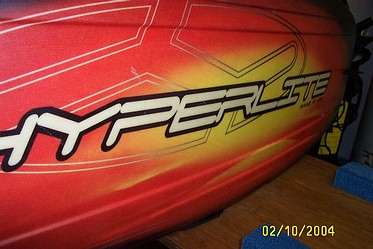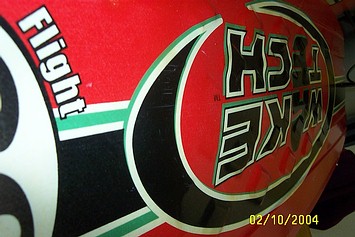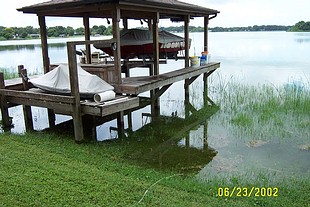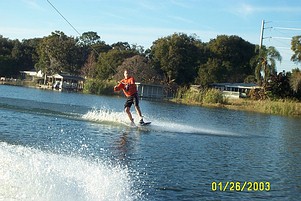| Author | Message | ||
Glitch |
dimples like a golf ball | ||
M1combat |
I think the theory there is that a cushion of air is more slippery than polished metal. Would it be beneficial to increase the ID of the stack about 2X the thickness of the "more turbulent" layer of air? I suppose that may decrease velocity though... Anyway, I'm sure you can all tell that I haven't got a clue about fluid dynamics  . . | ||
Turnagain |
dimples like a golf ball | ||
Hootowl |
My God, someone agrees with me about dimpling. Give me a minute to get back in my chair. | ||
Rd350 |
The dimple affect is true. Back in the 1990's GT Bicycle Company spent millions on making their riders faster for the Olympics. They used it on clothing to wheels. Seems that if you could make it work on the stack it would be interesting! | ||
Glitch |
Could we be on to something? Shorter with dimples and a rolled edge? | ||
Dynarider |
In the plastic world we refer to the boundry layer deal as a delta T. Just like a river where the water in a river will tend to move much faster in the middle, while the water right along the shoreline is stagnant & barely moves, plastic does the same thing in a screw & barrel setup. We try & break this up with different design screw flites & with mixing tips. I would imagine air flows in the same way, faster thru the core & not so well right along the surface of an object. I agree that the dimple idea on the interior surface of a stack may be the way to go. | ||
Nevco1 |
Dimpling works on golf balls and the old Shuberth helmet. The helmet didn't do so well, and the golf balls are age old technology. Consider the golf balls that use two or three sized dimples to further manage the laminar flow to reduce slicing or hooking. If you have a clue what is going on in your stack, the varied pattern may help. | ||
Anonymous |
It's fun to read this stuff; you guys are enjoying the topic. Re. the Corbin fairing, there is very specific math about golf ball dimpling that is well known in the world of aerodynamics. Subsonic aerodynamics is well known to those who study it, but many more just dabble in it. It's fun just to experiment, but if you really want results without tons of wasted experiments, you need to "go to school" on the subject. It takes a lot of schooling or reading on the topic to know it (way more than a few articles in Car and Driver or something). But when you do have the knowledge, it's really fun, because you can predict most of what will and won't work just looking at it. | ||
Ftd |
The river/water analogy is interesting. I am an avid wakeboarder. There are two schools of thought in wakeboard design. Smooth bottom vs dimpled bottom. Both advocates claim more board speed and pop off the wake.    | ||
Opto |
In subsonic aerodynamics, air is considered to be almost INcompressible and behaves almost like a fluid. (The "almost" bit allows theory to explain why an airfoil can generate lift). Bernoulli did heaps of research on venturis (read stack) many many years ago - probably worth doing a search on Bernoulli and venturi if you want more info on this subject. Or check this for a simple illustration http://home.earthlink.net/~mmc1919/venturi.html Note how the flow rate always remains the same from inlet to outlet. | ||
Blake |
Opto, Subsonic air flow is compressible, BIG time. Supersonic airflow is incompressible. Depending on the geometry and velocities involved, subsonic air flow can be idealized and modeled as incompressible. I think that is what you are thinking about in your statement above. However, I doubt that idealization holds well in the realm of an engine intake suffering under the environment of transient air flow (non-steady-state), but I could be wrong. I haven't really looked at the problem. | ||
Glitch |
Ok, now that we have a rolled edge, shorter, dimpled, stack, does anyone have any idea how we can chill the air as it goes through the stack.  As I was thinking of this last night, I wasn't worried about the size or arrangement of the dimples as much as how to get them there to begin with. this is one of the better threads here lately. | ||
Steveshakeshaft |
Completely off topic, but I can't help myself pointing out that the dimpling effect was (yet another) British discovery. The discovery was made by Barnes Wallace when he was developing the "bouncing bombs" used in rupturing the German dams in WWII. Very famous wartime story over here, how well known it is over there I haven't a clue! True though. Regards Steve www.ukbeg.com steve_s@ukbeg.com | ||
Buckinfubba |
man I just read thru all this stuff and my head hurts...... | ||
Jerseyguy |
Anonymous - Can you point me toward a practical text on the subject? All my old college texts are too theoretical. Forgetting cost for the moment, what is your opinion of the dimpled inside stack surface? Would it be worth the effort? Sometimes you have to think "outside the box". Ftd - I'm an avid wakeboarder as well. Ski Nautique, fat sacs, tower etc. - too many boards to mention Glitch - If we could come up with a pattern, lets say similar to a golf ball, I could machine that into most if not all of the stack that I have already made. The solid modeling is the hard part, but I can handle that once a pattern is identified. The machining time would be minimal. I'd mount the CNC turned OEM replica in a CNC milling machine and strategically touch the inside surface with a spherical end mill. There will be some practical limitations but I think it can be done. One thing - the effort will be costly and I have no intention of a "cut & try until you get it right" approach. There has to be a solid theoretical background as a starting point for what I do. Steve | ||
Jerseyguy |
Steves - I saw the movie of that event! It was called "The Dam Busters" Probably made in the 50's or 60's. Bubba - Have a beer and relax.... keep that dyno warmed up we may have something for you. | ||
Glitch |
When I worked for Hubbell there was an engineer there that had a modeling program for helping design molds for our injection molding. The program would show how the flow of plastic would fill the mold. You could enter the data so the program would flow plastics at a viscosity of water up to something like peanut butter. If we could get a hold of something like that we'd be golden. | ||
Glitch |
Jersey, are ya thinking of a matching cone also? | ||
Dynarider |
Another point to consider is maybe the motor is flowing as much air as it can get from the center of the stack & any additional gains to be made by gathering air from the sides of the stack wouldnt result in any extra hp? Would using a flow bench to match the stack against what the throttle body & the heads are capable of flowing be a better way to go? | ||
Road_thing |
Dimpling...simple!!  r-t  | ||
Jerseyguy |
Glitch - I hadn't thought of that. I suppose I could modify the stock lid, but I'm thinking one step at a time. Plus I don't have the exact geometry (+- .001 or better) like I do for the one I made. I do have the instrumentation to precisely define that geometry but its alot of work. Dyna - A thicker boundary layer significantly reduces the effective diameter. Remember that the area changes with the square of the radius. A flow bench would be cool, but what about the pulsations in the flow path? I've had one knowledgeable person tell me that the tuned length is key and another tell me that the inlet shape is everything and now we are discussing the surface design. All these things and others come into play. I wish I knew which of the variables were the major contributors! Here's a pic of the stocker in aluminum bead blasted.  | ||
Ftd |
Jersey Steve, Moomba, sacs, buckets with dirt, fat chicks (haha), etc. I live on Lake Holden in Orlando (epicenter of WBing). Neighbors (and occassionally ride with) Greg Necrasson, Dallas Friday and Cobe Mickocich. In 2000 I was second at the National Championships in the >40 age class. I ride at least once a week year round (in fact riding tomorrow after work). Interesting to hear that we share this common interest. That dimpled board is my 12 yr old Flight 69. I ride a Hyperlite Vero 143 currently. Pic of me riding is ~1/2 hour before the start of last year's Super Bowl. Frank   edited by ftd on February 10, 2004 | ||
Glitch |
Jersey, You do very nice work. Wish I had the knowledge, and the access to the tools you have. I am truly green with envy. | ||
Anonymous |
Jg, Dimpling will not help in the venturi. It's used on spheres basically as a crude way of making up for their lack of a tail, serving for vortex generation to make a less turbulent wake. Worked on the bounce bombs just like on golf balls because they were round bombs without tail fins. | ||
Turnagain |
Tornado Fuel Saver - Increase Horsepower Effects can't remember if these are the folks that had a in·fo·mer·cial. snake oil?? | ||
Anonymous |
The finest swamp adder type...make a great combo with a set of "nology" wires... | ||
S320002 |
A few years ago boat builders went to textured surfaces on the hulls Americas Cup racers to reduce drag caused by the boundary layer. Jersey, There is a equation to determine the length of velocity stacks at specific RPMs. I can't remember it right now. Maybe after my brain has had a rest I can derive it from scratch but don't hold your breath.  | ||
Jerseyguy |
Anon - Thanks for saving me the time. Have any other hints on how I can improve the stock design if cost, sound, epa, etc. isn't a factor? Glitch - I can't take all the credit. This is how it works. I take my thoughts and ideas and convert them into a representation of reality "on paper". Come to think of it there isn't even paper any more. The ideas get programmed by me right into solid model computer files that represent reality. These files get translated by a CNC programmer and his software to tool paths. The CNC machine then does all the beautiful machining. In today's world if you can dream it you can make pretty much anything. Witness a couple of dune buggys tooling around on Mars as we speak. What an awesome accomplishment and most folks don't even care. | ||
Bluzm2 |
Greg, If memory serves, 3M made a textured film that was used on one of the America's Cup yachts about 6 or 7 years ago. When they pulled the boat form the water after a race, they had curtains to hide the hull and keel. No one knew about the "friction reducing film" until after the race was over. I haven't heard much about it since. |


